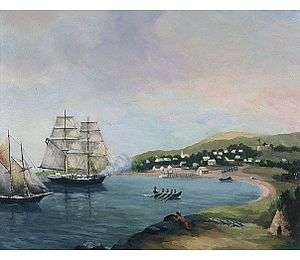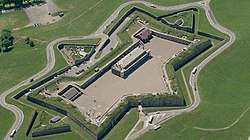Raid on Lunenburg, Nova Scotia (1782)
The Raid on Lunenburg (also known as the Sack of Lunenburg) occurred during the American Revolution when the US privateer, Captain Noah Stoddard of Fairhaven, Massachusetts, and four other privateer vessels attacked the British settlement at Lunenburg, Nova Scotia on 1 July 1782.[6][7][8] The raid was the last major privateer attack on a Nova Scotia community during the war.
Lunenburg was defended by militia leaders Colonel John Creighton and Major Dettlieb Christopher Jessen. In Nova Scotia, the assault on Lunenburg was the most spectacular raid of the war.[9] On the morning of 1 July Stoddard led approximately 170 US privateers in four heavily armed vessels and overpowered Lunenburg’s defence, capturing the blockhouses and burning the house of Jessen. The privateers then looted the settlement and kept the militia at bay with the threat of destroying the entire town. The American privateers plundered the town and took three prisoners, including Creighton, who were later released from Boston without a ransom having been paid.[9][10][11]
Historical context

During the American Revolution, Nova Scotia was invaded regularly by American Revolutionary forces by land and sea. Throughout the war, American privateers devastated the maritime economy by raiding many of the coastal communities. There were constant attacks by privateers,[12] which began seven years earlier with the Raid on St. John (1775) and included raids on all the major outposts in Nova Scotia. [13]
Lunenburg was engaged with American privateers numerous times during the war. In 1775, the 84th Regiment had been defending Nova Scotia, attacking an American privateer ship off of Lunenburg, Nova Scotia (1775). The 84th was led by Captain John MacDonald. They boarded the warship when some of its crew were ashore seeking plunder. They captured the crew and sailed her into Halifax.[14] In February 1778, Colonel Creighton appealed to the Government to address the "Mischiefs done to the settlement of Lunenburg by the New England Privateers". In response, the government ordered the armed vessel Loyal Nova Scotian to Lunenburg.[15] On 25 February 1780, while the American privateer Sally floated in Lunenburg harbour under the command of Moses Tinney, four American privateers came ashore for provisions. Colonel Creighton ordered the privateers to be taken prisoner and fired at their brigantine Sally. Creighton then ordered two boats of men to board Sally but the privateers resisted. Creighton ordered the blockhouse to fire two guns at the privateer. Sally surrendered and the privateers were taken prisoner and Sally brought to Halifax.[16] On March 18, 1780, the Lunenburg militia secured the American prisoners taken from the American privateer Kitty on the LaHave River. They took the vessel back to Lunenburg and sold it.[17][18] A month later, on 15 April 1780 the Lunenburg militia (35 men) and the British brigantine John and Rachael captured an American privateer prize, also named Sally, off LaHave River.[19] During the seizure, the privateers killed the head of the militia (McDonald) and wounded two of the crew members of John and Rachael.[20][21][22]
On March 15, 1782, Captain Amos Potter (released after the Raid on Annapolis Royal (1781)) returned from Boston in the Resolution and captured the schooner Two Sisters off Pearl Island, Mahone Bay (formerly Green Island), stole all the provisions on board and released it.[23]
The following month, Stoddard's vessel Scammell was commissioned in April 1782 and made the plan in Boston to raid Lunenburg.[24] Soon after, he rescued the 60 American prisoners on board HMS Blonde which was wrecked on Seal Island, Nova Scotia. Stoddard allowed the British crew to return to Halifax in HMS Observer (which was involved in the Naval battle off Halifax en route).[25][26]
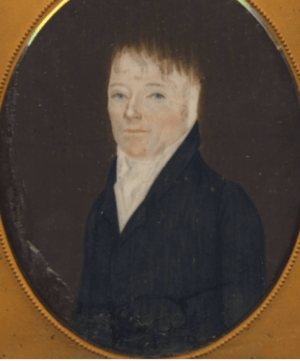
On June 30, the day before the raid on Lunenburg, Stoddard and two other privateers descended on Chester, Nova Scotia firing cannon from their vessels. Captain of the militia Jonathan Prescott informed the privateers that the military forces were gone from Lunenburg and were headed to Chester. In response, the American privateers left Chester and went on to attack Lunenburg.
Raid on Lunenburg
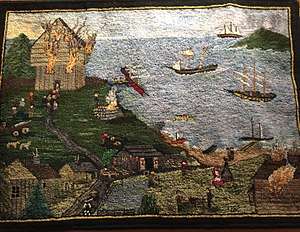
During the early morning of 1 July 1782, five American privateers, who had left Boston under the command of Captain Noah Stoddard, began to raid Lunenburg. Captain Stoddard's ship was the schooner Scammel, which had sixteen guns and sixty men.[9][27] Stoddard organized both a land and sea assault of the town. The vessels first landed at Red Head (present-day Blue Rocks), two miles outside of the town. From there, George Wait Babcock led 90 soldiers overland toward the town.[28][29] The vessels then moved toward a frontal assault on the town.
The Lunenburg militia of 20 men was led by Colonel John Creighton and Major D. C. Jessen. Colonel Creighton and five other militia men occupied the eastern blockhouse and began firing at the approaching land assault.[30] Several of Captain Stoddard’s privateers were wounded. The landed fleet of privateers then rounded East Point. The vessels landed and quickly took control of the western blockhouse and established themselves at Blockhouse Hill (See image above). Captain Creighton and others in the blockhouse were cannonaded into silence and the blockhouse burned.[31] Colonel Creighton surrendered and was taken prisoner along with two other men aboard Captain Stoddard’s vessel Scammel.[32]
Resistance was also offered by Major D. C. Jessen. He was initially held up in his home, which the privateers fired full of bullets. He escaped and his house was looted. Major Jessen assembled with a militia behind the hill overlooking the town. A militia from La Have under the command of Major Joseph Pernette also advanced toward Lunenburg to join Major Jessen. Captain Stoddard sent a message to Jensen and Pernette that if they advanced on the town, all the homes would be burned. To ensure his threat was not idle, Captain Stoddard burned down Major Jessen's home.[33]
Captain Stoddard’s privateers looted the town and destroyed what remained. The Reverend Johann Gottlob Schmeisser tried to intervene and was bound by the privateers and placed in the middle of town.[34]
Relief came when Lt. Governor Hamond dispatched from Halifax three ships under the command of Captain Douglass of HMS Chatham, one of which had 200 Hessians soldiers aboard.[35] Captain Stoddard began the retreat. Despite not having received a ransom, Captain Stoddard released Colonel Creighton and the other prisoners after they arrived in Boston.[33]
Sylvia, an African working for Creighton, was a significant part of Lunenburg's resistance to the raid. (Whether Sylvia was a free black or a slave is unknown. According to the St. Paul's Church (Halifax) cemetery records, she is listed as a "black servant". She died in Halifax on 12 March 1824 age 70 and is buried in the Old Burying Ground (Halifax, Nova Scotia).)[36] She assisted in supplying munitions to Creighton at the blockhouse and sheltered his son.[37] And after being released from being captured by Stoddard, she also protected the home and possessions of Major Jessen.[33][38]
Afterward
The raid on Lunenburg was the last major privateer attack of the war. On August 29, 1782 American privateer Wasp (19 men) under the command of Captain Thomas Thompson captured a vessel off Chester. He then spent two nights on East Ironbound Island. On September 1 Wasp sailed to Pennant Point where they were confronted by three men from Sambro, Nova Scotia who fired on them, killing one of his crew and wounding three others including Captain Thomas Thompson. Captain Perry took command of the vessel and the privateers took one of the Sambro men prisoner. The privateers buried their crew member on an island in Pennant bay. They then began their return to Massachusetts by rowing to West Dover, Nova Scotia and then on to Cross Island ("Croo Island") just off Lunenburg ("Malegash").[39] [40] On 3 September 1782, Henry Vogle of the Lunenburg militia recaptured a shallop taken by American privateers, which was witnessed by those on Wasp.[41] On September 5, Wasp tried to enter LaHave River but was fired on by the local inhabitants so continued on to Port Medway.[42]
Gallery


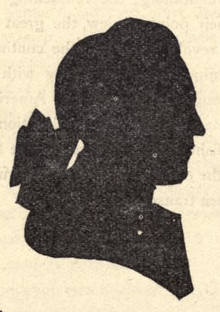
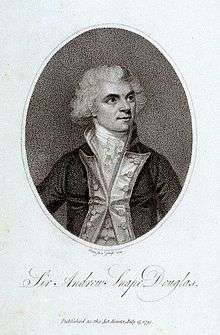 Captain Andrew Snape Douglas
Captain Andrew Snape Douglas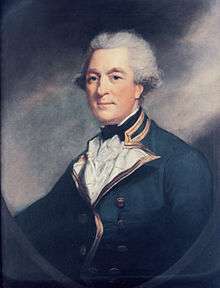
In fiction
- Jan Andrews. The Dancing Sun: A Celebration of Canadian Children, 1981
- Joyce Barkhouse. "The Heroine of Lunenburg", with illustrations by Peter Ferguson
See also
References
- ↑ Author of The Holy Communion: A Relic of the Past and an Instructor of the Present : Being a Sermon Written in the Year A.D. 1797
- ↑ p.338
- ↑ Capt. John Tibbets' (1748-1786)
- ↑ casualties taken from Boston Gazette, July 15, August 5, 1782 ; Massachusetts Spy, August 8, 1782
- ↑ https://archive.org/stream/massachusettshis77mass#page/176/mode/2up/search/halifax
- ↑ Eastman, pp. 61–63
- ↑ Captain Noah Stoddard, died in New Bedford, January 29, 1850, aged 95 ; a soldier of the Revolution.
- ↑ p.7
- 1 2 3 Gwyn, p. 75
- ↑ DesBraisay, p. 68
- ↑ Beamish Murdoch, History of Nova Scotia. Vol. 3, p. 6
- ↑ Benjamin Franklin also engaged France in the war, which meant that many of the privateers were also from France.
- ↑ Raids happened at Liverpool (October 1776, March 1777, September 1777, May 1778, September 1780) and on Annapolis Royal (1781) (Roger Marsters (2004). Bold Privateers: Terror, Plunder and Profit on Canada's Atlantic Coast", pp. 87–89 ISBN 0887806449)
- ↑ Craig, C. (1989). The Young Emigrants: Craigs of the Magaguadavic, p. 53
- ↑ Naval Documents, Vol. 3, p. 424
- ↑ pp. 310-311
- ↑ p. 224
- ↑ https://archive.org/stream/ahistorynovasco01murdgoog#page/n627/mode/1up/search/tartar
- ↑ Sally was a prize recently capture by the American privateer General Stark under the command Captain James Pearson on 27 March 1780. The American privateer and her prize got separated in a storm, with the prize ending up at the mouth of the LaHave River.
- ↑ pp. 310-311
- ↑ [https://archive.org/stream/americanvesselsc00nova#page/71/mode/1up/search/nova+scotia American vessels captured by the British during the American Revolution, pp. 71-72
- ↑ Privateers also killed South Shore men who served on loyalist armed vessels (see Nova Scotia Gazette, July 11, 1780; July 13, 1780; Harvey, ed. Perkins Diary, pp. 28-29.
- ↑ Beamish Murdoch. A History of Nova Scotia, Vol. 3, p. 4
- ↑ The Boston Gazette, and the Country Journal, Monday, July 15, 1782; The Massachusetts Spy: Or, American Oracle of Liberty [Worcester], Thursday, July 25, 1782; The Continental Journal [Boston], Thursday, July 18, 1782. Joseph Pernette to Franklin, letter, dated at La Have, July 3, 1782, reprinted in DesBrisay, Mather Byles, History of the County of Lunenburg, Toronto: Wesley Briggs, 1895, 65-67.
- ↑ Sacking of Lunenburg. Saga of the Seas, Archibald MacMechan, 1923
- ↑ Thomas Head Raddall. Adventures of H.M.S. Blonde in Nova Scotia, 1778-1782. Collections of the Nova Scotia Historical Society. 1966.
- ↑ MacMechan, p. 59
- ↑ There is also a source that indicates the landing party was led by Lieutenant George Bateman
- ↑ Massachusetts Historical Society Collections
- ↑ Three of these men were Mathew Ernst, Ferdinand Miller and Frederick Blysteiner. (See Desbrasay, p. 65
- ↑ Gwyn, p. 25
- ↑ MacMechan, pp. 62–63
- 1 2 3 MacMechan, p. 68
- ↑ MacMechan, p. 67
- ↑ Scammell
- ↑ "Archived copy". Archived from the original on 2015-04-16. Retrieved 2015-01-08.
- ↑ MacMechan refers to Sylvia as a servant. It is unclear whether her status was that of an indentured servant or a slave.
- ↑ Sylvia Hamilton. "A Survey of Early Black Women in Nova Scotia". In We're Rooted Here and They Can't Pull Us Up.
- ↑ John Fairbanks - His Journal. Collections of the Maine Historical Society
- ↑ American Privateer Wasp
- ↑ p. 93
- ↑ In October 1782, Wasp was engaged by a British packet. The British killed 3 and wounded 10 if the 19 crew members on Wasp. See p.29
Bibliography
- A Naval History of the American Revolution
- DesBrisay, Mather Byles (1895). History of the county of Lunenburg, pp. 62-68
- Eastman, Ralph M. "Captain Noah Stoddard" in Some Famous Privateers of New England. 1928. pp. 61–63
- Gwyn, Julian. Frigates and Foremasts: The North American Squadron in Nova Scotia Waters, 1745–1815, University of British Columbia Press. 2003 ISBN 0774809116.
- MacMechan, Archibald (1923), “The Sack of Lunenburg” in Sagas of the Sea. The Temple Press, pp. 57–72.
- A History of American Privateers
- Massachusetts Privateers, p. 176
- Agnes Creighton, "An Unforeclosed Mortgage," Acadiensis, October, 1905
- Primary documents
- The Boston Gazette, and the Country Journal, Monday, July 15, 1782;
- The Massachusetts Spy: Or, American Oracle of Liberty [Worcester], Thursday, July 25, 1782;
- The Continental Journal [Boston], Thursday, July 18, 1782.
- Joseph Pernette to Franklin, letter, dated at La Have, July 3, 1782, reprinted in DesBrisay, Mather Byles, History of the County of Lunenburg, Toronto: Wesley Briggs, 1895, 65–67.
- Leonard Rudolf's account in Invasion of Lunenburg in Acadie and the Acadians
Further reading
- Howe, Octavius Thorndike. Beverly Privateers in the Revolution, 1922, p. 361.
- Bell, Winthrop Pickard. (1961). The "Foreign Protestants" and the Settlement of Nova Scotia.
- "Privateering and piracy: the effects of New England raiding upon Nova Scotia during the American Revolution, 1775–1783". By John Dewar Faibisy
External links
- Sack of Lunenburg Plaque
- Sacking of Lunenburg – Primary Sources
- Beck, J. Murray (1983). "Creighton, John (1721-1807)". In Halpenny, Francess G. Dictionary of Canadian Biography. V (1801–1820) (online ed.). University of Toronto Press.
- Sack of Lunenburg – American War of Independence at Sea
- MA Scammel
